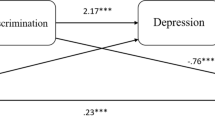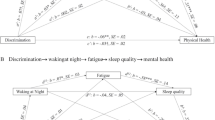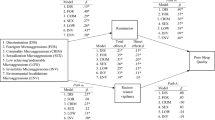Abstract
This review provides a model explicating two related physiologic and behavioral pathways through which the chronic daily stress of the expectation and experience of discrimination exposure can shape life course cardiometabolic risk trajectories: sleep and stress reactivity. We argue that these two pathways work together jointly to shape African American-White disparities in cardiometabolic morbidities. The body’s ongoing anticipation of experiencing racism-related stressors disrupts sleep, a behavior highly responsive to stress reactivity, which is also elevated during stressful conditions. The constant feedback between sleep disruption and the body’s stress response can lead to higher allostatic load and disproportionate exposure to stress-related illness among African Americans earlier in their life course.



Similar content being viewed by others
References
Adam, E. K., Heissel, J. A., Zeiders, K. H., Richeson, J. A., Ross, E. C., Ehrlich, K. B., et al. (2015). Developmental histories of perceived racial discrimination and diurnal cortisol profiles in adulthood: A 20-year prospective study. Psychoneuroendocrinology, 62, 279–291. doi:10.1016/j.psyneuen.2015.08.018.
Almazan, E. P., Roettger, M. E., & Acosta, P. S. (2014). Measures of sexual minority status and suicide risk among young adults in the United States. Archives of Suicide Research, 18(3), 274–281. doi:10.1080/13811118.2013.824832.
Balbo, M., Leproult, R., & Van Cauter, E. (2010). Impact of sleep and its disturbances on hypothalamo-pituitary-adrenal axis activity. International Journal of Endocrinology. doi:10.1155/2010/759234.
Balfour, P. C., Jr., Rodriguez, C. J., & Ferdinand, K. C. (2015). The role of hypertension in race-ethnic disparities in cardiovascular disease. Curr Cardiovasc Risk Rep. doi:10.1007/s12170-015-0446-5.
Beatty, D. L., Hall, M. H., Kamarck, T. A., Buysse, D. J., Owens, J. F., Reis, S. E., et al. (2011). Unfair treatment is associated with poor sleep in African American and Caucasian adults: Pittsburgh SleepSCORE project. Health Psychology: Official Journal of the Division of Health Psychology, American Psychological Association, 30(3), 351–359. doi:10.1037/a0022976.
Becker, S. P., Langberg, J. M., & Byars, K. C. (2015). Advancing a biopsychosocial and contextual model of sleep in adolescence: A review and introduction to the special issue. Journal of Youth and Adolescence, 44(2), 239–270. doi:10.1007/s10964-014-0248-y.
Bonilla-Silva, E. (2015). The structure of racism in color-blind, “Post-Racial” America. American Behavioral Scientist. doi:10.1177/0002764215586826.
Brody, G. H., Lei, M.-K., Chae, D. H., Yu, T., Kogan, S. M., & Beach, S. R. H. (2014). Perceived discrimination among african american adolescents and allostatic load: A longitudinal analysis with buffering effects. Child Development, 85(3), 989–1002. doi:10.1111/cdev.12213.
Brody, G. H., Yu, T., Miller, G. E., & Chen, E. (2015). Discrimination, racial identity, and cytokine levels among African-American adolescents. Journal of Adolescent Health, 56(5), 496–501. doi:10.1016/j.jadohealth.2015.01.017.
Brotman, D. J., Golden, S. H., & Wittstein, I. S. (2007). The cardiovascular toll of stress. Lancet, 370(9592), 1089–1100. doi:10.1016/S0140-6736(07)61305-1.
Buckley, T. M., & Schatzberg, A. F. (2005). On the interactions of the hypothalamic-pituitary-adrenal (HPA) axis and sleep: Normal HPA axis activity and circadian rhythm, exemplary sleep disorders. The Journal of Clinical Endocrinology & Metabolism, 90(5), 3106–3114. doi:10.1210/jc.2004-1056.
CDC. (2011). Unhealth sleep and sleep related behaviors. Retrieved from https://www.cdc.gov/features/dssleep/.
CDC. (2015). Insufficient sleep is a public health problem. Retrieved from https://www.cdc.gov/features/dssleep/.
Chambers, E. C., Tull, E. S., Fraser, H. S., Mutunhu, N. R., Sobers, N., & Niles, E. (2004). The relationship of internalized racism to body fat distribution and insulin resistance among African adolescent youth. Journal of the National Medical Association, 96(12), 1594–1598.
Clark, R., Anderson, N. B., Clark, V. R., & Williams, D. R. (1999). Racism as a stressor for African Americans: A biopsychosocial model. American Psychologist, 54(10), 805–816. doi:10.1037/0003-066X.54.10.805.
Clark, R., Benkert, R. A., & Flack, J. M. (2006). Large arterial elasticity varies as a function of gender and racism-related vigilance in black youth. Journal of Adolescent Health, 39(4), 562–569. doi:10.1016/j.jadohealth.2006.02.012.
Cohen, S., Schwartz, J. E., Epel, E., Kirschbaum, C., Sidney, S., & Seeman, T. (2006). Socioeconomic status, race, and diurnal cortisol decline in the Coronary Artery Risk Development in Young Adults (CARDIA) Study. Psychosomatic Medicine, 68(1), 41–50. doi:10.1097/01.psy.0000195967.51768.ea.
Cozier, Y. C., Wise, L. A., Palmer, J. R., & Rosenberg, L. (2009). Perceived racism in relation to weight change in the Black Women’s Health Study. Annals of Epidemiology, 19(6), 379–387. doi:10.1016/j.annepidem.2009.01.008.
Daw, J. (2017). Contribution of four comorbid conditions to racial/ethnic disparities in mortality risk. American Journal of Preventive Medicine, 52(Supplement 1), S95–S102. doi:10.1016/j.amepre.2016.07.036.
DeSantis, A. S., Adam, E. K., Doane, L. D., Mineka, S., Zinbarg, R. E., & Craske, M. G. (2007). Racial/ethnic differences in cortisol diurnal rhythms in a community sample of adolescents. Journal of Adolescent Health, 41(1), 3–13. doi:10.1016/j.jadohealth.2007.03.006.
DeSantis, A. S., Adam, E. K., Hawkley, L. C., Kudielka, B. M., & Cacioppo, J. T. (2015). Racial and ethnic differences in diurnal cortisol rhythms: Are they consistent over time? Psychosomatic Medicine, 77(1), 6–15.
Fuller-Rowell, T. E., Curtis, D. S., El-Sheikh, M., Duke, A. M., Ryff, C. D., & Zgierska, A. E. (2016). Racial discrimination mediates race differences in sleep problems: A longitudinal analysis. Cultural Diversity and Ethnic Minority Psychology, 23(2), 165.
Fuller-Rowell, T. E., Doan, S. N., & Eccles, J. S. (2012). Differential effects of perceived discrimination on the diurnal cortisol rhythm of African Americans and Whites. Psychoneuroendocrinology, 37(1), 107–118. doi:10.1016/j.psyneuen.2011.05.011.
Geronimus, A. T., Hicken, M., Keene, D., & Bound, J. (2006). “Weathering” and age patterns of allostatic load scores among blacks and whites in the United States. American Journal of Public Health, 96(5), 826–833. doi:10.2105/AJPH.2004.060749.
Geronimus, A. T., & Thompson, J. P. (2004). To denigrate, ignore, or disrupt: Racial inequality in health and the impact of a policy-induced breakdown of African American communities. Du Bois Review, 1(02), 247–279.
Gluckman, P. D., Hanson, M. A., & Spencer, H. G. (2005). Predictive adaptive responses and human evolution. Trends in Ecology & Evolution, 20(10), 527–533. doi:10.1016/j.tree.2005.08.001.
Goosby, B. J., Cheadle, J. E., & McDade, T. (2016). Birth weight, early life course BMI, and body size change: Chains of risk to adult inflammation? Social Science and Medicine, 148, 102–109. doi:10.1016/j.socscimed.2015.11.040.
Goosby, B. J., & Heidbrink, C. (2013). The transgenerational consequences of discrimination on African-American health outcomes. Sociology Compass, 7(8), 630–643. doi:10.1111/soc4.12054.
Goosby, B. J., Malone, S., Richardson, E. A., Cheadle, J. E., & Williams, D. T. (2015). Perceived discrimination and markers of cardiovascular risk among low-income African American youth. Am J Hum Biol. doi:10.1002/ajhb.22683.
Green, T. L., & Darity, W. A. (2010). Under the skin: Using theories from biology and the social sciences to explore the mechanisms behind the black-white health gap. American Journal of Public Health, 100(Suppl 1), S36–S40. doi:10.2105/AJPH.2009.171140.
Hairston, K. G., Bryer-Ash, M., Norris, J. M., Haffner, S., Bowden, D. W., & Wagenknecht, L. E. (2010). Sleep duration and five-year abdominal fat accumulation in a minority cohort: The IRAS Family Study. Sleep, 33(3), 289–295.
Hale, L., & Do, D. P. (2007). Racial differences in self-reports of sleep duration in a population-based study. Sleep, 30(9), 1096–1103.
Hale, L., & Rivero-Fuentes, E. (2011). Negative acculturation in sleep duration among Mexican immigrants and Mexican Americans. Journal of Immigrant and Minority Health, 13(2), 402–407. doi:10.1007/s10903-009-9284-1.
Harrell, C. J. P., Burford, T. I., Cage, B. N., Nelson, T. M., Shearon, S., Thompson, A., et al. (2011). Multiple pathways linking racism to health outcomes. Du Bois Review, 8(1), 143–157.
Hicken, M. T., Lee, H., Ailshire, J., Burgard, S. A., & Williams, D. R. (2013). “Every shut eye, ain’t sleep”: The role of racism-related vigilance in racial/ethnic disparities in sleep difficulty. Race and Social Problems, 5(2), 100–112. doi:10.1007/s12552-013-9095-9.
Hoggard, L. S., & Hill, L. K. (2016). Examining how racial discrimination impacts sleep quality in African Americans: Is perseveration the answer? Behavioral Sleep Medicine, 1–14.
Huynh, V. W., Guan, S.-S. A., Almeida, D. M., McCreath, H., & Fuligni, A. J. (2016). Everyday discrimination and diurnal cortisol during adolescence. Hormones and Behavior, 80, 76–81. doi:10.1016/j.yhbeh.2016.01.009.
Irwin, M. R. (2015). Why sleep is important for health: a psychoneuroimmunology perspective. Annual Review of Psychology, 66, 143–172. doi:10.1146/annurev-psych-010213-115205.
Jamieson, J. P., Koslov, K., Nock, M. K., & Mendes, W. B. (2013). Experiencing discrimination increases risk taking. Psychological Science, 24(2), 131–139. doi:10.1177/0956797612448194.
Kaestner, R., Pearson, J. A., Keene, D., & Geronimus, A. T. (2009). Stress, allostatic load and health of Mexican immigrants. Social Science Quarterly, 90(5), 1089–1111. doi:10.1111/j.1540-6237.2009.00648.x.
Kern, S., Oakes, T. R., Stone, C. K., McAuliff, E. M., Kirschbaum, C., & Davidson, R. J. (2008). Glucose metabolic changes in the prefrontal cortex are associated with HPA axis response to a psychosocial stressor. Psychoneuroendocrinology, 33(4), 517–529. doi:10.1016/j.psyneuen.2008.01.010.
Kingsbury, J. H., Buxton, O. M., & Emmons, K. M. (2013). Sleep and its relationship to racial and ethnic disparities in cardiovascular disease. Current Cardiovascular Risk Reports. doi:10.1007/s12170-013-0330-0.
Krueger, P. M., & Friedman, E. M. (2009). Sleep duration in the United States: A cross-sectional population-based study. American Journal of Epidemiology, 169(9), 1052–1063. doi:10.1093/aje/kwp023.
Lauderdale, D. S. (2006). Birth outcomes for Arabic-named women in California before and after September 11. Demography, 43(1), 185–201.
Lee, H. E., Lee, D., Guo, G., & Harris, K. M. (2011). US trends in body mass in adolescence and young adulthood, 1959–2002. The Journal of Adolescent Health: Official Publication of the Society for Adolescent Medicine, 49(6), 601–608. doi:10.1016/j.jadohealth.2011.04.019.
Lewis, T. T., Aiello, A. E., Leurgans, S., Kelly, J., & Barnes, L. L. (2010). Self-reported experiences of everyday discrimination are associated with elevated C-reactive protein levels in older African-American adults. Brain, Behavior, and Immunity, 24(3), 438–443. doi:10.1016/j.bbi.2009.11.011.
Lewis, T. T., Barnes, L. L., Bienias, J. L., Lackland, D. T., Evans, D. A., & Mendes de Leon, C. F. (2009). Perceived discrimination and blood pressure in older African American and white adults. The Journals of Gerontology Series A: Biological Sciences and Medical Sciences, 64A(9), 1002–1008.
Lewis, T. T., Cogburn, C. D., & Williams, D. R. (2015). Self-reported experiences of discrimination and health: Scientific advances, ongoing controversies, and emerging issues. Annual Review of Clinical Psychology, 11(1), 407–440. doi:10.1146/annurev-clinpsy-032814-112728.
Lewis, T. T., Everson-Rose, S., Powell, L. H., Matthews, K. A., Brown, C., Karavolos, K., et al. (2006). Chronic exposure to everyday discrimination and coronary artery calcification in African-American women: The SWAN Heart Study. Psychosomatic Medicine, 68(3), 362–368.
Lewis, T. T., Troxel, W. M., Kravitz, H. M., Bromberger, J. T., Matthews, K. A., & Hall, M. (2013). Chronic exposure to everyday discrimination and sleep in a multi-ethnic sample of middle-aged women. Health Psychology: Official Journal of the Division of Health Psychology, American Psychological Association, 32(7), 810–819. doi:10.1037/a0029938.
Marino, M., Li, Y., Rueschman, M. N., Winkelman, J. W., Ellenbogen, J. M., Solet, J. M., et al. (2013). Measuring sleep: Accuracy, sensitivity, and specificity of wrist actigraphy compared to polysomnography. Sleep, 36(11), 1747–1755. doi:10.5665/sleep.3142.
Matthews, K. A., & Pantesco, E. J. M. (2016). Sleep characteristics and cardiovascular risk in children and adolescents: An enumerative review. Sleep Medicine, 18, 36–49. doi:10.1016/j.sleep.2015.06.004.
McEwen, B. S. (1998). Stress, adaptation, and disease: Allostasis and allostatic load. Annals of the New York Academy of Sciences, 840, 33–44.
McEwen, B. S. (2004). Protection and damage from acute and chronic stress: Allostasis and allostatic overload and relevance to the pathophysiology of psychiatric disorders. Annals of the New York Academy of Sciences, 1032, 1–7. doi:10.1196/annals.1314.001.
McEwen, B. S. (2006). Sleep deprivation as a neurobiologic and physiologic stress: Allostasis and allostatic load. Metabolism, Clinical and Experimental, 55(Supplement 2), s20–s23.
Meerlo, P., Sgoifo, A., & Suchecki, D. (2008). Restricted and disrupted sleep: Effects on autonomic function, neuroendocrine stress systems and stress responsivity. Sleep Medicine Reviews, 12(3), 197–210. doi:10.1016/j.smrv.2007.07.007.
Mezick, E. J., Matthews, K. A., Hall, M., Strollo, P. J., Jr., Buysse, D. J., Kamarck, T. W., et al. (2008). Influence of race and socioeconomic status on sleep: Pittsburgh SleepSCORE project. Psychosomatic Medicine, 70(4), 410–416. doi:10.1097/PSY.0b013e31816fdf21.
Miller, G. E., Chen, E., & Zhou, E. S. (2007). If it goes up, must it come down? Chronic stress and the hypothalamic-pituitary-adrenocortical axis in humans. Psychological Bulletin, 133(1), 25–45. doi:10.1037/0033-2909.133.1.25.
Miller, G. E., Cohen, S., & Ritchey, A. K. (2002). Chronic psychological stress and the regulation of pro-inflammatory cytokines: A glucocorticoid-resistance model. Health Psychology, 21(6), 531–541. doi:10.1037/0278-6133.21.6.531.
Mozaffarian, D., Benjamin, E. J., Go, A. S., Arnett, D. K., Blaha, M. J., Cushman, M.,… Stroke Statistics, S. (2016). Heart disease and stroke statistics-2016 update: A report from the American Heart Association. Circulation, 133(4), e38–e360. doi:10.1161/CIR.0000000000000350.
Nakajima, H., Kaneita, Y., Yokoyama, E., Harano, S., Tamaki, T., Ibuka, E., et al. (2008). Association between sleep duration and hemoglobin A1c level. Sleep Medicine, 9(7), 745–752. doi:10.1016/j.sleep.2007.07.017.
NCHS. (2012). Health, United States, 2011: With special feature on socioeconomic status and health. Hyattsville, MD: National Center for Health Statistics.
Nijm, J., & Jonasson, L. (2009). Inflammation and cortisol response in coronary artery disease. Annals of Medicine, 41, 224–233.
Padela, A. I., & Raza, A. (2015). American Muslim health disparities: the state of the Medline literature. Journal of Health Disparities Research and Practice, 8(1), 1.
Pepin, J.-L., Borel, A.-L., Tamisier, R., Baguet, J.-P., Levy, P., & Dauvilliers, Y. (2014). Hypertension and sleep: Overview of a tight relationship. Sleep Medicine Reviews, 18(6), 509–519. doi:10.1016/j.smrv.2014.03.003.
Petrov, M. E., & Lichstein, K. L. (2016). Differences in sleep between black and white adults: An update and future directions. Sleep Medicine, 18, 74–81. doi:10.1016/j.sleep.2015.01.011.
Phelan, J. C., & Link, B. G. (2015). Is racism a fundamental cause of inequalities in health? Annual Review of Sociology, 41(1), 311–330. doi:10.1146/annurev-soc-073014-112305.
Poh, M.-Z., Swenson, N. C., & Picard, R. W. (2010). A wearable sensor for unobtrusive, long-term assessment of electrodermal activity. IEEE Transactions on Biomedical Engineering, 57(5), 1243–1252.
Powell, L. R., Jesdale, W. M., & Lemon, S. C. (2016). On edge: The impact of race-related vigilance on obesity status in African-Americans. Obesity Science & Practice, 2(2), 136–143. doi:10.1002/osp4.42.
Quist, J. S., Sjödin, A., Chaput, J.-P., & Hjorth, M. F. (2016). Sleep and cardiometabolic risk in children and adolescents. Sleep Medicine Reviews, 29, 76–100. doi:10.1016/j.smrv.2015.09.001.
Reskin, B. (2012). The race discrimination system. Annual Review of Sociology, 38(1), 17–35. doi:10.1146/annurev-soc-071811-145508.
Richardson, L. J., & Brown, T. H. (2016). (En)gendering racial disparities in health trajectories: A life course and intersectional analysis. SSM-Population Health, 2, 425–435. doi:10.1016/j.ssmph.2016.04.011.
Rodriguez, J. M., Geronimus, A. T., Bound, J., & Dorling, D. (2015). Black lives matter: Differential mortality and the racial composition of the U.S. electorate, 1970-2004. Social Science and Medicine, 136–137, 190–192. doi:10.1016/j.socscimed.2015.04.014.
Sadeh, A. (2011). The role and validity of actigraphy in sleep medicine: An update. Sleep Medicine Reviews, 15(4), 259–267. doi:10.1016/j.smrv.2010.10.001.
Sano, A., & Picard, R. W. (2011). Toward a taxonomy of autonomic sleep patterns with electrodermal activity. Paper presented at the Engineering in Medicine and Biology Society, EMBC, 2011 Annual International Conference of the IEEE.
Sapolsky, R. M. (2004). Why zebras don’t get ulcers/Robert M. Sapolsky (3rd ed.). New York: Times Books.
Sapolsky, R. M., Romero, L. M., & Munck, A. U. (2000). How do glucocorticoids influence stress responses? Integrating permissive, suppressive, stimulatory, and preparative actions. Endocrine Reviews, 21(1), 55–89. doi:10.1210/edrv.21.1.0389.
Skinner, M. L., Shirtcliff, E. A., Haggerty, K. P., Coe, C. L., & Catalano, R. F. (2011). Allostasis model facilitates understanding race differences in the diurnal cortisol rhythm. Development and Psychopathology, 23(4), 1167–1186. doi:10.1017/S095457941100054X.
Slopen, N., Lewis, T. T., & Williams, D. R. (2016). Discrimination and sleep: A systematic review. Sleep Medicine, 18, 88–95. doi:10.1016/j.sleep.2015.01.012.
Slopen, N., & Williams, D. R. (2014). Discrimination, other psychosocial stressors, and self-reported sleep duration and difficulties. Sleep, 37(1), 147–156. doi:10.5665/sleep.3326.
Sterling, P. (2003). Principles of allostasis: Optimal design, predictive regulation, pathophysiology and rational therapeutics. In J. Schulkin (Ed.), Allostasis, homeostasis, and the costs of adaptation. Cambridge: MIT Press.
Sterling, P. (2012). Allostasis: A model of predictive regulation. Physiology & Behavior, 106(1), 5–15. doi:10.1016/j.physbeh.2011.06.004.
Sternthal, M. J., Slopen, N., & Williams, D. R. (2011). Racial disparities in health: How much does stress really matter? Du Bois Review, 8(1), 95–113.
Swan, M. (2013). The quantified self: Fundamental disruption in big data science and biological discovery. Big Data, 1(2), 85–99. doi:10.1089/big.2012.0002.
Thomas, K. S., Bardwell, W. A., Ancoli-Israel, S., & Dimsdale, J. E. (2006). The toll of ethnic discrimination on sleep architecture and fatigue. Health Psychology: Official Journal of the Division of Health Psychology, American Psychological Association, 25(5), 635–642. doi:10.1037/0278-6133.25.5.635.
Tomfohr, L., Cooper, D. C., Mills, P. J., Nelesen, R. A., & Dimsdale, J. E. (2010). Everyday discrimination and nocturnal blood pressure dipping in black and white americans. Psychosomatic Medicine, 72(3), 266–272. doi:10.1097/PSY.0b013e3181d0d8b2.
Tomfohr, L., Pung, M. A., Edwards, K. M., & Dimsdale, J. E. (2012). Racial differences in sleep architecture: The role of ethnic discrimination. Biological Psychology, 89(1), 34–38. doi:10.1016/j.biopsycho.2011.09.002.
Tull, E. S., Cort, M. A., Gwebu, E. T., & Gwebu, K. (2007). Internalized racism is associated with elevated fasting glucose in a sample of adult women but not men in Zimbabwe. Ethnicity and Disease, 17(4), 731–735.
Van Cauter, E., Spiegel, K., Tasali, E., & Leproult, R. (2008). Metabolic consequences of sleep and sleep loss. Sleep Medicine, 1(Supplement 1), S23–S28. doi:10.1016/S1389-9457(08)70013-3.
Williams, D. R. (2012). Miles to go before we sleep: Racial inequities in health. Journal of Health and Social Behavior, 53(3), 279–295. doi:10.1177/0022146512455804.
Zeiders, K. H., Hoyt, L. T., & Adam, E. K. (2014). Associations between self-reported discrimination and diurnal cortisol rhythms among young adults: The moderating role of racial-ethnic minority status. Psychoneuroendocrinology, 50, 280–288. doi:10.1016/j.psyneuen.2014.08.023.
Acknowledgements
The authors would like to thank participants of the National Institute of Child Health and Human Development and European Research Council (United Kingdom) “How Social Environments Get Under the Skin” workgroup and Thom McDade for their helpful feedback on earlier drafts of this manuscript. This research was funded by a University of Nebraska Minority Health Disparities Award and is part of a larger study funded by the Eunice Kennedy Shriver National Institute of Child Health and Human Development (K01 HD 064537, Bridget Goosby, PI).
Author information
Authors and Affiliations
Corresponding author
Rights and permissions
About this article
Cite this article
Goosby, B., Straley, E. & Cheadle, J. Discrimination, Sleep, and Stress Reactivity: Pathways to African American-White Cardiometabolic Risk Inequities. Popul Res Policy Rev 36, 699–716 (2017). https://doi.org/10.1007/s11113-017-9439-z
Received:
Accepted:
Published:
Issue Date:
DOI: https://doi.org/10.1007/s11113-017-9439-z




